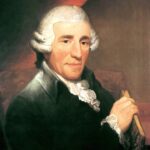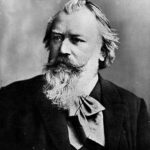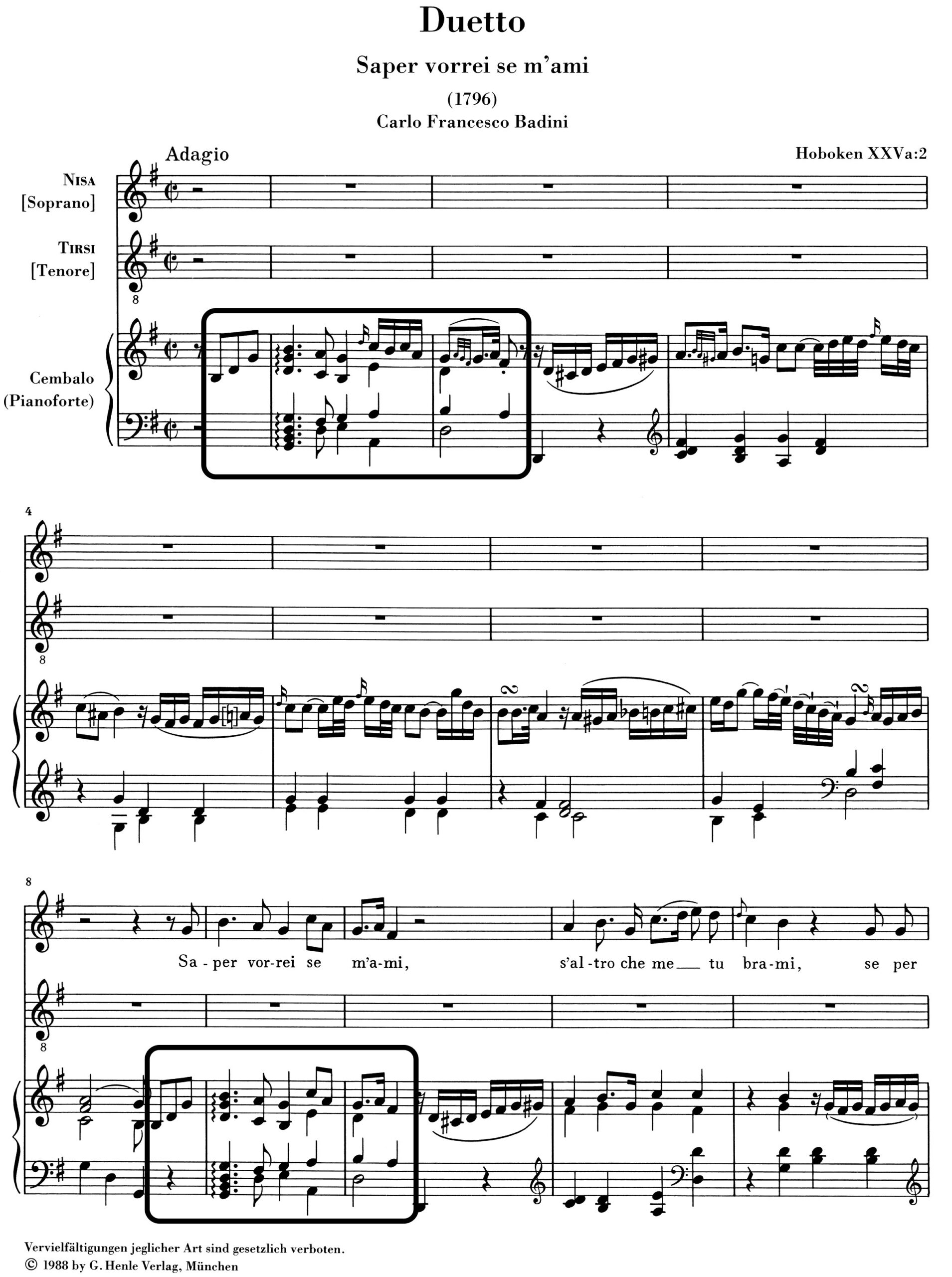 Here’s a situation familiar to music lovers: By chance you hear a music piece, usually on the radio, but you just can’t recall the composer. You’re getting more frustrated: this can’t be true, you can sing along with every note – and yet you simply can’t place the piece. That’s exactly what happened to me a few months ago, though as soon as I heard the simple duet accompanied by piano (on the car radio), I knew that something here “just couldn’t be quite right”. Although all too well I recognised the beautiful melody heard at the opening of the piece, but I had certainly never heard the piece itself before. So, the melody had to have come from another context – but from where, from where in the world? And who was the composer of the radio duet? Perhaps something by Mozart unknown to me (shame on me …)?
Here’s a situation familiar to music lovers: By chance you hear a music piece, usually on the radio, but you just can’t recall the composer. You’re getting more frustrated: this can’t be true, you can sing along with every note – and yet you simply can’t place the piece. That’s exactly what happened to me a few months ago, though as soon as I heard the simple duet accompanied by piano (on the car radio), I knew that something here “just couldn’t be quite right”. Although all too well I recognised the beautiful melody heard at the opening of the piece, but I had certainly never heard the piece itself before. So, the melody had to have come from another context – but from where, from where in the world? And who was the composer of the radio duet? Perhaps something by Mozart unknown to me (shame on me …)?
The radio announcer solved the second riddle: it was Joseph Haydn’s duet “Saper vorrei se m’ami” Hob. XXVa:2. Listen to it here – and agree with me: this love duet is just simply gorgeous! I quickly located it in the Henle catalogue. We offer “Saper vorrei” together with another Haydn duet as a slim Urtext edition, its music text is taken from the Haydn Complete Edition (Series XXIX | volume 2).
But how did I know the lovely, tender opening melody? It’s first heard at the beginning in the piano introduction, then the soprano enters with it alongside the piano’s right hand: “Saper vorrei se m’ami” (I would like to know if you love me).
Because the melodic line is very distinctive, I immediately started searching and entered the first eight notes (“B-D-G-B-A-G-C-A”) into the RISM-OPAC keyboard search engine (“Advanced Search”). I wondered whether RISM would “spew out” the piece that I knew? In fact, I even got two hits (as of 5 June 2022): though only the Haydn title I already knew from two sources (with, incidentally, the title of the two protagonists “Nisa [Soprano] et Tirsi [Tenore]”). So, I had to extend the search and omit “C-A”: now RISM found 389 (!) titles with this specific triadic note sequence, including a lot of “misses”, because the RISM search engine (alas!) doesn’t distinguish octave positions in the melodic incipit entered. RISM spewed out 21 hits when I typed in the first seven notes of the Haydn piece. Again, “our” Haydn appears several times and also – very interesting! – a lovely piano minuet by Antonin Dvořák, op. 28 no. 1. To make a long story short: The music piece that the Haydn incipit so strongly reminded me of wasn’t among them.[1] I gave up in despair.
Months passed and, as in “real” life, anguish gave way to gradual oblivion until I was sitting in the concert by the “Quatuor Ébène” when they played – divinely beautiful – the second movement from Brahms’s String Quartet in B-flat major op. 67. A (hushed) outcry escaped me: there it was, the melody I was looking for:
Isn’t that really striking? 10 identical opening notes in a row, rhythmically slightly different, but composed in the style like siblings (that is, the emphasis on the high notes a2 and b-flat2, as well as the strong leading note f2):
That solved the riddle. The Haydn duet heard on the car radio reminded me of one of my favourite string quartet movements. (Incidentally, I shared this “find” with the Ébène Quartet immediately after the concert – and they were immediately completely convinced of this so far completely undiscovered parallel).
All that remains is the question (perhaps ultimately unimportant?) of whether here Brahms is actually “quoting” Haydn, consciously or unconsciously, or whether this melody is just “lying out there in the middle of the road”, so to speak: that is, was perhaps being used by Haydn and Brahms, absolutely independent of each other. The Dvořák example mentioned above may suggest this, also showing the same note sequence as in Haydn and Brahms. But, from experience, I remain sceptical, for in Dvořák’s work, the melody is played in lively, even, smooth eighth notes, whilst Brahms and Haydn, on the other hand, put it in the (almost identical) rhythm, thus actually making a “melody” out of the mere note succession. Apart from that, Brahms could not have known the Dvořák “melody” at all for reasons of chronology.
 Haydn, after all, as a model for quotation? We know how well Brahms knew, indeed loved, his Haydn. If that’s news to you and you’re looking for solid, stimulating information on this topic, you can access the excellently informative and wonderfully illustrated catalogue of the Lübeck Brahms Institute: “Kontinuitäten? Symposium: Joseph Haydn im Wandel der Interpretationen – Ausstellung: Joseph Haydn und Johannes Brahms” (Continuities? Symposium: Joseph Haydn in Changing Interpretations – Exhibition: Joseph Haydn and Johannes Brahms). The question on my mind was whether, after all, Brahms was acquainted with the Haydn duet. So, I turned to one of the best specialists on both (!) composers. Otto Biba was kind enough to help me – Thank you very much, dear Dr Biba! He consulted all available music resources in Vienna’s “Gesellschaft der Musikfreunde” archives that could have given clues to an encounter between Brahms and the Haydn piece: [2] Nada!
Haydn, after all, as a model for quotation? We know how well Brahms knew, indeed loved, his Haydn. If that’s news to you and you’re looking for solid, stimulating information on this topic, you can access the excellently informative and wonderfully illustrated catalogue of the Lübeck Brahms Institute: “Kontinuitäten? Symposium: Joseph Haydn im Wandel der Interpretationen – Ausstellung: Joseph Haydn und Johannes Brahms” (Continuities? Symposium: Joseph Haydn in Changing Interpretations – Exhibition: Joseph Haydn and Johannes Brahms). The question on my mind was whether, after all, Brahms was acquainted with the Haydn duet. So, I turned to one of the best specialists on both (!) composers. Otto Biba was kind enough to help me – Thank you very much, dear Dr Biba! He consulted all available music resources in Vienna’s “Gesellschaft der Musikfreunde” archives that could have given clues to an encounter between Brahms and the Haydn piece: [2] Nada!
So, the mystery remains for the time being, as to
- whether Brahms anonymously “quotes” Haydn in the main theme of the Andante in op. 67,
- or whether he was merely unconsciously inspired by Haydn’s duet, perhaps because he had once held Haydn’s music score in his hands or even attended a performance,
- or whether it was simply a “heavenly” coincidence.
If we really want to assume a quotation – whether hidden or unconscious – the text of the Haydn duet would certainly make us prick up our ears: “I would like to know if you love me”. It would be facetious not to think immediately of Clara Schumann as the secret addressee. In the preface to our Urtext edition, Clara Schumann’s diary entry is quoted: “The Adagio [sic] (second movement) is to me not significant enough for Brahms”, whereupon the Urtext editor speculates (probably rightly) that the drastic corrections in the autograph of the second movement could possibly be owing to Clara’s dissatisfaction. The floodgates are hereby happily open to speculation….
But perhaps we should leave the uncertainty at that. And at least cherish Brahms’s wonderful (recurring) F major melody in the Andante of his String Quartet op. 67 as a love song. This can now be “verified” with certainty by the text of the beautiful Haydn duet. Anyone, however, having ears to hear would have known this even before my blog post today.
[1] The IMSLP melody search doesn’t work. (To program SUCH a thing would be a real step forward for musical humanity, instead of just offering industrious music note copiers a platform for their sad everyday life). And even APPLE’s two music-finding apps “Sound Hound” and “Shazam” could not identify Haydn or even “my” search title.
[2] See: Critical Report of the above-cited, pertinent volume of the Haydn Complete Edition, p. 103: [1] Early copyist’s copy of Hob. XXVa:2 “Saper vorrei…”, A-Wgm, shelfmark VI 6096/2 (Q 5942); [2] early edition from Simrock (RISM H 2592); [3] early edition from Breitkopf & Härtel, “Œuvres completes” volume VIII.



